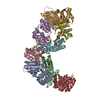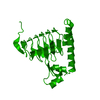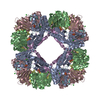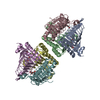+Search query
-Structure paper
| Title | Computational design of self-assembling protein nanomaterials with atomic level accuracy. |
|---|---|
| Journal, issue, pages | Science, Vol. 336, Issue 6085, Page 1171-1174, Year 2012 |
| Publish date | Jun 1, 2012 |
 Authors Authors | Neil P King / William Sheffler / Michael R Sawaya / Breanna S Vollmar / John P Sumida / Ingemar André / Tamir Gonen / Todd O Yeates / David Baker /  |
| PubMed Abstract | We describe a general computational method for designing proteins that self-assemble to a desired symmetric architecture. Protein building blocks are docked together symmetrically to identify ...We describe a general computational method for designing proteins that self-assemble to a desired symmetric architecture. Protein building blocks are docked together symmetrically to identify complementary packing arrangements, and low-energy protein-protein interfaces are then designed between the building blocks in order to drive self-assembly. We used trimeric protein building blocks to design a 24-subunit, 13-nm diameter complex with octahedral symmetry and a 12-subunit, 11-nm diameter complex with tetrahedral symmetry. The designed proteins assembled to the desired oligomeric states in solution, and the crystal structures of the complexes revealed that the resulting materials closely match the design models. The method can be used to design a wide variety of self-assembling protein nanomaterials. |
 External links External links |  Science / Science /  PubMed:22654060 / PubMed:22654060 /  PubMed Central PubMed Central |
| Methods | EM (single particle) / X-ray diffraction |
| Resolution | 2.21 - 20.0 Å |
| Structure data |  EMDB-5438:  PDB-3vcd:  PDB-4dcl:  PDB-4ddf:  PDB-4egg: |
| Chemicals |  ChemComp-SO4:  ChemComp-CL:  ChemComp-HOH:  ChemComp-GOL: |
| Source |
|
 Keywords Keywords |  ELECTRON TRANSPORT / self assembling octahedral cage design / ELECTRON TRANSPORT / self assembling octahedral cage design /  TRANSFERASE / self assembling tetrahedron design TRANSFERASE / self assembling tetrahedron design |
 Movie
Movie Controller
Controller Structure viewers
Structure viewers About Yorodumi Papers
About Yorodumi Papers




